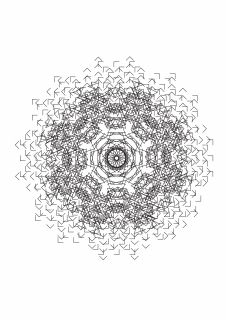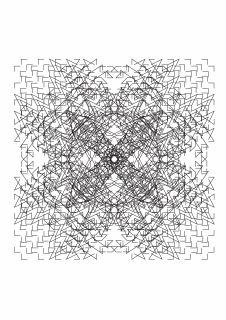

From top to bottom: Allah, Al-Akhir (The Last).
|
Lulwah Al-Homoud is designing a new path from the roots of our earliest thinking to the present and, who knows, the end or a final idea. She does so without talking and without the help of preachers or diplomats. She simply uses mathematics, Islamic mathematics and mathematics which were there already, to recalculate the essential words of creation. 'She calls it The Language of Existence,' somebody wrote, so it is, if she did so. Its alphabet exists of the 99 most beautiful names of Allah, which Al-Homoud is 'deconstructing and recallibrating' into patterns reminicent of Islamic geometry. The new patterns interestingly include, from the moment of the first human cell devision, all brothers born before and after Abraham. So we see, believe and calculate her work. The way in which the artist works, from an understanding that Arabic letters have proportions which represent mathematical codes, is to use these codes to deconstruct or break letters into simpler lines as building material for new geometrical designs. For the computation of the break Al-Homoud went looking for codes by writing on ancient 'Vedic squares' from North India. Such squares contain a multiplication system, which she altered to fit better the growth and development of humanity. She changed the numerical progression of 1 to 9 in the square's first row and column to a progression of 1,2,4,6,8,16,32,64 etc in reference to human cells which multiply and grow by devision, as often religions do too. The Vedic square then needs mergers, because like humans it allows no more than one digit in its own cells. So 16 becomes 7, 32 becomes 5 and 64 becomes 10 and then 1. Just one. Try this yourself: numbering 64 religions and then recomputating them into 1. And if you skip the math but employ preachers and diplomats, then you understand why there is art. If just to think of an idea and not immediately abandon it. The end result of The Language of Existence is a computer generated geometrical design, which was recallibrated from the deconstructed words and silkscreen printed on paper (editions of 20, 118,8 x 89,8 cm). By the end of 2008 the artist could show around 14 finished names of the most beautiful 99 ones. Coming from the very different visual tradition of calligraphy Al-Homoud's art is similar in it's basic act to what Mondrian or Malevich have done with their western figurative world. Her recallibrated The Last would survive well in the company of Malevich's ultimate vision Black Square. Al-Homoud is from Riyadh, where she majored in sociology at King Saud University, and was the first Saudi to complete a MA at Central St Martins College of Art and Design in London. She has had lessons in calligraphy from Rashid Butt and was inspired by Ahmed Moustafa to learn about a 10th century theoretical system of calligraphy. In 2006 she participated in a British Museum managed project to have Arab artists work in schools. She spent six weeks at a school in London 'Exploring Calligraphy and Arab design.' She has participated in and co-curated the 2008 Edge of Arabia exhibition in SOAS Brunei Gallery. Her work was chosen by Christie's in April 2009 for their Middle East auction in Dubai. Sources: www.edgeofarabia.com © All rights reserved. |
|
From top to bottom: Allah, Al-Akhir (The Last). |